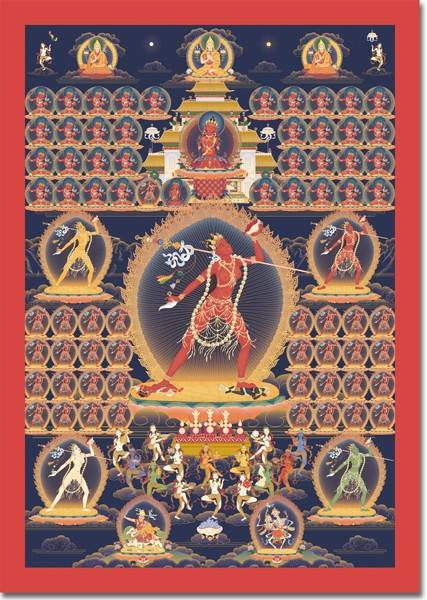
| LOST SADHANAS.ORG | THE LOST SADHANAS PROJECT |

The Vajra Yogini says,
One of the many difficulties of having a traumatic past is the fear that one could be thrown back into the situation where the trauma occurred.Repeating traumatic memories knock on the door of awareness and say, "Resolve me", "Pay attention to me." The emotional knot associated with the trauma needs to be untied.
Traumas have a central knot that maintains them. Often that knot involves the fear of death. This fear is sometimes tied up with the fear of physical and emotional pain.
Once a person realizes that death is a transition and not the end, it is the pain that becomes central. Pain can be remembered and released. But fear of pain tied up with fear of death can be harder to bear, and to transform.
Trauma shows an attack on the soul. It is a partial death, a blackening of the sensitive parts of the self. Some warrior training methods will intentionally traumatize recruits to make them less sensitive, and to create callouses on the heart as well as on the body. Then these people live only for war, and to do to others what was done to them. When war is over, they lose their reason to live.
Some traumas result from people surviving attacks, torture, and isolation. Others come from forced violation of love, making children kill their parents or friends. Such traumas are mortal wounds, affecting the person's values and ideals. These are active rather than passive traumas.
But most traumas come not from what people have done, but from what was done to them. Whether deliberately or by accident, people harm the souls and bodies of others. While physical wounds can be cleansed and healed, soul wounds are invisible and thus much harder to heal.
Acts of hatred and aggression can harm souls, but lies can as well. False blaming and scapegoating makes holes in the soul, which are sometimes marked on the skin as ulcers and rashes.
The more traumas, the more the soul dies. They draw the soul into a realm of darkness. Even the veils of ignorance covering these traumas are like diseases of the soul. Admitting their existence is the first stage of healing.
But it must be followed by untangling the knots and finding the arrowheads of hatred, anger, and disgust that are lodged in the soul. The soul defends itself from further damage by fear. It refuses to confront the problem. This can avoid even further attacks, but the inflammation from the initial attacks is still there. As it festers, it becomes like a whirlpool drawing emotion into ever widening circles of pain.
The arrowheads must be pulled out of the soul. The poison from each past event or set of events must be faced and acknowledged. The person must be able to understand and explain the attacks by identifying each attacker, and understanding his or her motivations. Blame should be redistributed, and underlying guilt or innocence affirmed.
When abuse has gone on for years, layer after layer of hatred and anger must be removed. The underlying inflammation for each layer must be cleansed. It can be a long process, especially if the experiences of past lives are involved.
Curses make the process more difficult for they bind destructive emotions to the soul to create continuous torment. Rather than having a few arrowheads of hate, curses expand them into beds of nails bound with leather thongs which allow the iron nails to pierce the soul through time. They cannot just be washed away over time. They remain until a skilled guide can help remove them.
Traumas knot ideas and desires, making mats of confusion and fear. As with matted hair, the knots must be found and undone. One cannot brush one's hair with knots in it, and it is difficult to be free to travel spiritually with unresolved traumas.
Please click on the [ NEXT ] link below to continue.
[ BACK ] The River of Pain [ NEXT ] The Vajrayogini Explains the Sambhogakaya